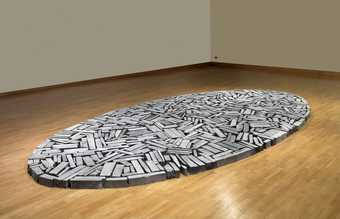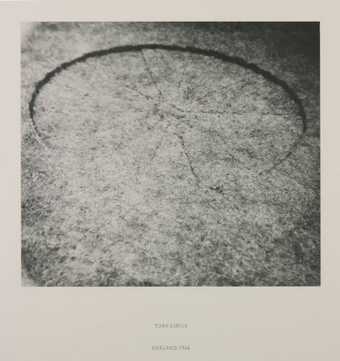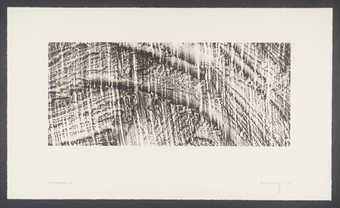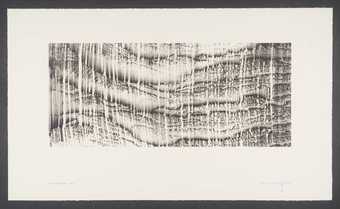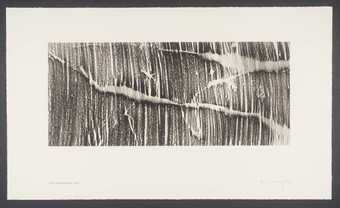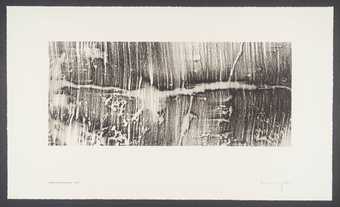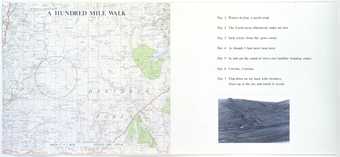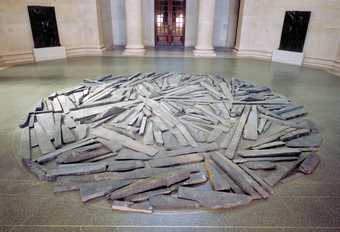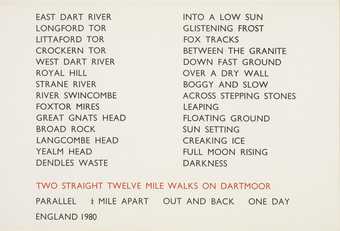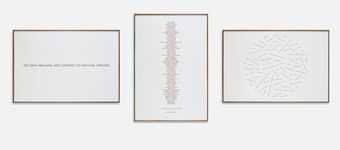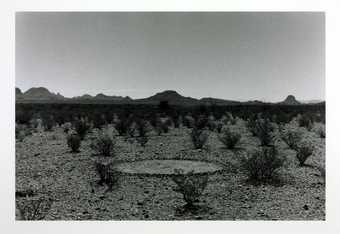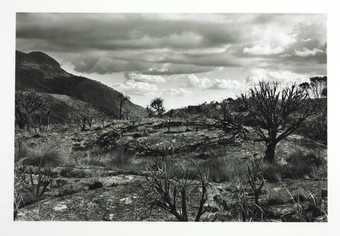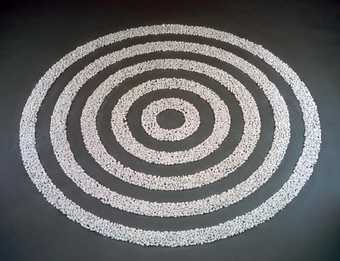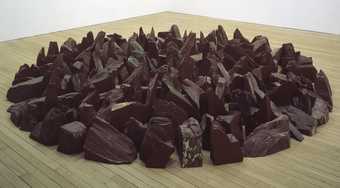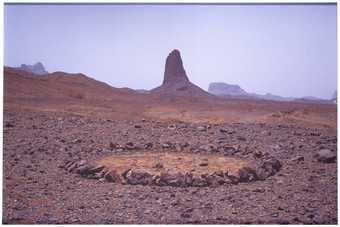
Not on display
- Artist
- Richard Long CBE born 1945
- Medium
- Delabole slate
- Dimensions
- Displayed: 100 × 1997 × 1997 mm
- Collection
- Tate
- Acquisition
- Presented by Janet Wolfson de Botton 1996
- Reference
- T07159
Summary
South Bank Circle
was created specifically for Long’s 1991 retrospective at the Hayward Gallery at the South Bank Centre in London. It is a circle, nearly two metres in diameter, composed of 168 pieces of slate lying close together on the floor. The slate comes from the Delabole quarry in Cornwall. The pieces may be assembled in a wide variety of configurations within the defining form of the circle. Long has specified that every ‘stone’ should touch the stones adjoining it, so that they all become ‘”locked” together, and stable. The longest stones (and also the thinnest and smallest ones) should be placed within the work and not around the edge. There is an equal density of stone throughout, and overall the work should look balanced and circular’ (South Bank Circle certificate, Gallery Records, Tate Archive, London). Bringing together the unevenly shaped pieces of slate in the geometric structure of the circle, the sculpture illustrates a theme common in Long’s work, the relationship between man and nature. As he has explained, ‘you could say that my work is ... a balance between the patterns of nature and the formalism of human, abstract ideas like lines and circles. It is where my human characteristics meet the natural forces and patterns of the world, and that is really the kind of subject of my work’ (quoted in Richard Long: Walking in Circles, p.250).
Long bases his work on walks made outdoors in nature, often in remote locations. The documentation of these walks, which takes a variety of different forms, constitutes the visible manifestation of the artwork, which for Long exists as much in the making of it as in its end product. As well as arranging objects encountered on his walks at points along the way, since the late 1960s Long has brought such organic elements as sticks and stones into gallery and museum spaces. Here, as on his walks, he lays them in such geometric configurations as circles, straight lines, crosses and spiralling squares. Circle of Sticks 1973 (Tate T01783) is a circle composed of seventy-six twigs from Leigh Woods, near Bristol (Long’s home), laid end to end on the gallery floor, delineating the outline of a circle. Small White Pebble Circles 1987 (Tate T07160) comprises five concentric circles of white marble pebbles. Slate Circle 1979 (Tate T03027) and Norfolk Flint Circle 1990 (Tate T06483), like South Bank Circle, are solid circles made on the floor using larger stones acquired from quarries.
Stone is one of the earliest materials used by man to fashion tools, construct dwellings, create monuments and to mark territory. Long has picked up and arranged stones on his walks in many of the world’s most remote locations. It is one of his preferred materials and he has said: ‘I like the idea that stones are what the world is made of.’ (Quoted in Richard Long: Circles Cycles Mud Stones, p.24.) He has commented: ‘everything has its right place in the world. There are millions of stones in the world, and when I make a sculpture, all I do is just take a few of those stones and bring them together and put them in a circle and show you ... I use stones because I like stones or because they’re easy to find, without being anything special, so common you can find them anywhere ... It’s enough to use stones as stones, for what they are. I’m a realist.’ (Quoted in Richard Long: Walking in Circles, p.45.) For his large-scale stone works Long often selects materials from whatever is available in a stoneyard or quarry near the exhibition site. He draws up a list of instructions from the physical concepts worked out during assembly and produces a certificate when the work is completed. South Bank Circle may be installed both indoors and outdoors.
Further reading:
Monique Beudert, Sean Rainbird, Contemporary Art: The Janet Wolfson de Botton Gift, exhibition catalogue, Tate Gallery Publishing, London 1998, p.9, reproduced (colour) p.38
Richard R. Brettell, Dana Friis-Hansen, Richard Long: Circles Cycles Mud Stones, exhibition catalogue, Contemporary Arts Museum, Houston 1996
Richard Long: Walking in Circles, exhibition catalogue, South Bank Centre, London 1991
Elizabeth Manchester
October 2001
Does this text contain inaccurate information or language that you feel we should improve or change? We would like to hear from you.
Display caption
Gallery label, March 2004
Does this text contain inaccurate information or language that you feel we should improve or change? We would like to hear from you.
Explore
- abstraction(8,615)
-
- from recognisable sources(3,634)
-
- landscape(1,191)
- non-representational(6,161)
-
- geometric(3,072)
- miscellaneous(732)
-
- slate(19)
- UK counties(19,585)
-
- Cornwall(1,034)
- England(19,202)
- England, South West(3,507)
- England, Southern(8,982)
You might like
-
Richard Long CBE Cornish Slate Ellipse
2009 -
Richard Long CBE Turf Circle
1966 -
Richard Long CBE Slate Drawing One
2002 -
Richard Long CBE Slate Drawing Two
2002 -
Richard Long CBE Limestone Drawing One
2002 -
Richard Long CBE Limestone Drawing Two
2002 -
Richard Long CBE A Hundred Mile Walk
1971–2 -
Richard Long CBE Slate Circle
1979 -
Richard Long CBE Two Straight Twelve Mile Walks on Dartmoor, England 1980
1980 -
Richard Long CBE Ten Days Walking and Sleeping on Natural Ground
1986 -
Richard Long CBE Silence Circle Big Bend Texas
1990 -
Richard Long CBE Circle in Africa
1978 -
Richard Long CBE Small White Pebble Circles
1987 -
Richard Long CBE Red Slate Circle
1988 -
Richard Long CBE Sahara Circle
1988

